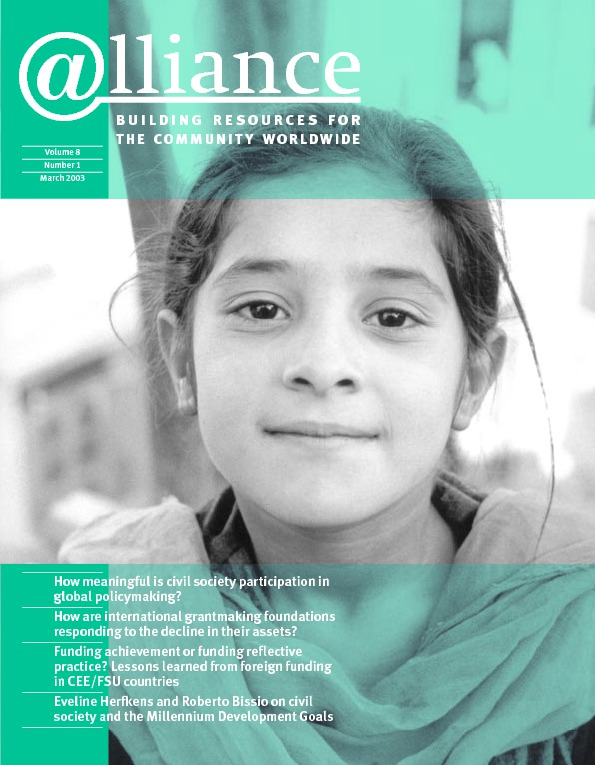No cheers were heard in Managua when the World Bank, flanked by the European government donor agencies, called in the Nicaraguan Government and NGOs and announced that the new game in town was PRSP. After two years of preparation, the document was formally approved by the World Bank last December. The process and content have served only to confirm the NGOs’ worst fears.
The new Washington mantra was clear: poverty relief and consultations with civil society – or, as some officials correctly mumbled, one more conditionality in order to access debt relief and new loans. The new mantra came with its own manual for poverty-mapping and its own ‘participation’ methodology, along with a highly paid contingent of ‘poverty experts’.
The fears …
It was the insistence on civil society participation that made Arnoldo Aleman’s government uneasy. Aleman argued that economic policymaking was central government’s task and the Nicaraguan people had already been consulted through participation in the recent elections.
Nicaraguan NGOs were similarly uneasy. Since the Hurricane Mitch disaster in October 1998, the Coordinadora Civil[1] and other civil society groups had been demanding that political and institutional reconstruction go hand in hand with physical and infrastructure reconstruction, with a view to securing the inclusion of those most afflicted by the disaster and also by poverty and governmental incompetence. Discussions transcended matters of poverty and relief, going on to tackle crucial questions such as the model of development and the nature of globalization.
The PRSP announcement brought this debate to a screeching halt. Now we were back to discussing poverty and poverty relief instead of poverty eradication and impoverishment as the byproduct of corporate-led globalization.
… and the reality
Like government, NGOs could only grumble and bow their heads in the light of the asymmetrical power realities. Key international NGOs such as Oxfam insisted ‘there was no alternative’ and this was our big chance to influence Bank and government policy! Our job was to quickly organize consultations with a view to feeding into the ‘nationally owned’ poverty reduction strategy. Along with the Washington blueprint came an absurdly tight time frame for organizing consultations.
As the proceedings filtered upwards, political protests over government corruption were carefully censored, as were criticisms of the structural adjustment programme, debt repayment schedules and neoliberal macroeconomic fundamentals in general. Community-level and NGO inputs were furthered watered down by the big business sector,[2] which was also represented on the Council on Social and Economic Planning (CONPES), designated by government as the channel for making ‘recommendations’ for the ‘broad-based’ poverty relief strategy to be adopted by government for submission to the Bank et al.
Much to the shock of NGOs busy carrying out consultations, CONPES learned that government was already working with a Bank-prepared version (in English!) of the ‘nationally owned’ poverty relief strategy. The game was up. The critics seemed to have been proved right: civil society participation was a joke, or at most a public relations exercise. Successive drafts of the strategy incorporated the old structural adjustment conditionalities, including debt repayment, privatization of the national power company, and other macroeconomic liberalization measures.
In short, the Bank and the IMF – and therefore the loan-hungry Nicaraguan Government – didn’t give an inch on macroeconomic fundamentals. As some officials admitted privately, what matters to them is economic growth. In neoliberal thinking, this means that adoption of the liberalization, structural adjustment, debt-repaying canon will bring investment and ‘confidence’, which in turn will alleviate poverty. Whether the model itself produces poverty is not up for discussion.
As if to prove that poverty relief was never a primary consideration, the so-called benefits of debt relief were to be continually held up as Nicaragua failed to qualify for the HIPC[3] facility and indeed for most foreign cooperation, not because there were no poor, but because the government proved unable to meet the macroeconomic conditions set by the Bank and IMF. Ironically, meeting those conditions in January 2003 in the form of a new agreement with the IMF spells further privatization and liberalization, cuts in education and health spending, firing of state employees and cutbacks in the availability of credit for small farmers. There you have the PRSP. Visit us again in a decade and maybe trickle-down will reach the poor yet!
1 The principal NGO coalition, created in the aftermath of the Hurricane Mitch disaster.
2 The business sector is also considered a part of ‘civil society’ by the Bank and government. The Coordinadora Civil has one seat on CONPES.
3 Highly Indebted Poor Countries Initiative; see box on p00.
Alejandro Bendaña is President of the Centro de Estudios Internacionales, Managua, Nicaragua (www.ceinicaragua.org.ni) and a member of the international coordinating committee of Jubilee South. He can be contacted at cei@ibw.com.ni


Comments (0)